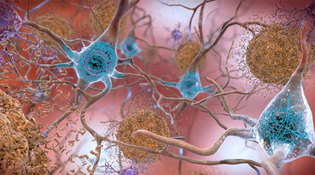
National Institutes of Health
Tau proteins accumulate and form tangles in Alzheimer’s-afflicted brains.
View full image
Every 66 seconds, someone in the US develops Alzheimer’s disease. The neurological condition inexorably destroys the brain’s cognitive circuits and kills more people annually than breast and prostate cancers combined.
The major risk factor for the common late-onset form is age itself. Now, researchers at the School of Medicine have examined how the molecular and cellular-level changes of aging can affect certain neurons, such that the neurons fill with neurofibrillary tangles and die.
A key factor, they say, is loss of calcium regulation. Amy Arnsten, the Albert E. Kent Professor of Neuroscience and Psychology and a senior author of the paper, explains that the neuronal circuits responsible for higher cognitive
functions—memory, learning, thinking—have specialized molecular properties. “Neurons involved with these functions have to activate themselves without sensory stimulation, a process that requires high levels of calcium. But the calcium must remain tightly controlled. If the regulation of calcium is lost, calcium can initiate toxic actions within the neurons.”
The researchers, from the labs of both Arnsten and psychiatry professor Angus Nairn, found that the proteins that regulate calcium signaling in younger brains diminish with age, resulting in the calcium’s “leaking” out of its “safe storage” in the smooth endoplasmic reticulum and into other parts of the cell. Their work was published in Alzheimer’s and Dementia.
This disruption of calcium storage correlates with a process in which tau—a protein that helps stabilize the cell’s cytoskeleton—becomes phosphorylated: phosphates attach themselves to the tau proteins and disrupt their functioning. “When the tau is phosphorylated,” Arnsten says, “it changes shape, ultimately leading to the neurofibrillary tangles that are a hallmark of Alzheimer’s, and to profound cognitive impairment.” Finding ways to restore calcium regulation could slow the disease, or lead to paths to treatment.
 loading
loading